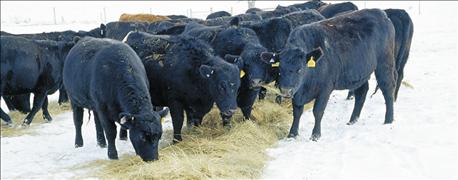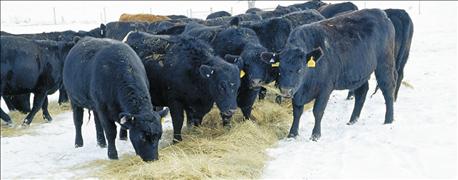December 13, 2016

Replacement heifers and calves destined to spend summer 2017 grazing should only gain between 1.5 and 2 pounds per day this winter.
“Replacement heifers and calves that will spend next summer grazing as yearlings will be managed quite differently than calves going on either a fast-track backgrounding or calf-fed finishing program,” says Warren Rusche, South Dakota State University Extension beef feedlot management associate.
Maximum performance is not the goal. Instead, the goal should be to strike a balance by reducing overall wintering costs without compromising future productivity.

FINE-TUNING: Calves headed to the pasture — not the feedlot — in the spring shouldn’t get too fleshy. Aim for 1.5 to 2 pounds of gain per day, says SDSU cattle feeding specialist.
"Getting calves too fleshy during the winter results in reduced summer gains in yearlings and negative effects on lifetime productivity in replacement heifers,” he says.
Be careful not to reduce inputs too much, because it can reduce pregnancy rates in replacement heifers and reduce marbling potential in growing cattle.
Performance targets between 1.5 and 2 pounds per day should avoid negative outcomes in most cases, Rusche says.
Right feeding program
Frame size can be a guide to selecting the right feeding program. A long yearling program allows the smaller-framed, lighter calves time to add frame before going on a finishing diet, resulting in increased hot carcass weights without negatively affecting marbling.
On the other hand, feeding larger-framed, higher-performing cattle diets that restrict their growth potential will depress marbling.
"A downside of feeding calves to gain at a relatively slow average daily gain is that the total cost of gain per pound will almost always be more expensive compared to programs targeting greater performance," Rusche says.
Feed costs to meet the calf's maintenance requirements as well as all fixed yardage expenses have to be borne by fewer pounds of gain.
"These programs should focus on reducing costs per day for the winter, with the objective of achieving cheaper gains during the grazing period," he says. "Owning the calves all the way to the end of the grazing period maximizes the opportunities to recapture any performance lost during the winter."
Winter grazing
Utilizing winter grazing resources when feasible is one strategy to reduce the total costs of a wintering program.
"Research from SDSU has demonstrated that grazing replacement heifers offers clear benefits in lifetime cow productivity," Rusche says.
If grazing resources are available and the weather permits, grazing lower-quality roughage combined with supplemental protein can reduce total cost of production.
A downside of these growing programs, Rusche points out, is that producers can be exposed to more risk because of a longer ownership period. "Owning cattle longer means more time to see falling cattle prices, and more opportunities for cattle to get sick or die," he says. "Sound preventive health programs and risk management plans are vitally important to avoid dramatic impacts on a ranch's financial position."
Changing weather conditions can also wreak havoc on marketing or production plans.
Limited grass availability and drought conditions can drastically affect demand for grass cattle and replacement heifers.
"Having a ‘Plan B’ in place can be very important to avoid being forced to dump cattle in an unfavorable market environment," he says.
Source: SDSU
You May Also Like




